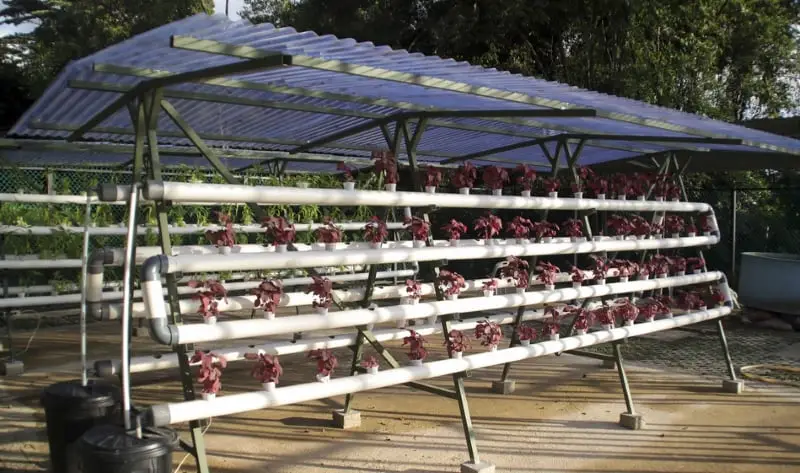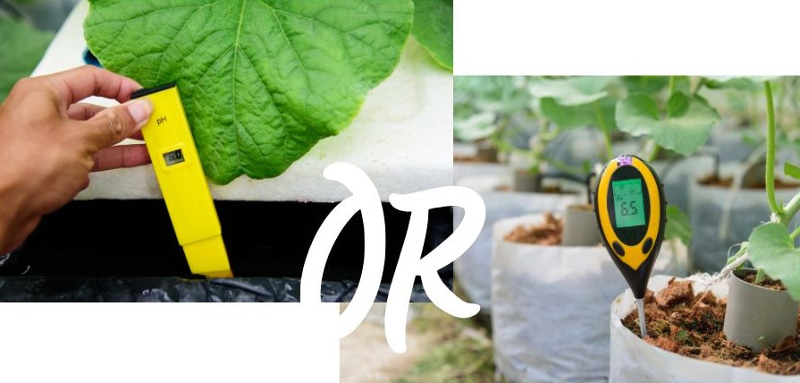Imagine stepping into your backyard and being greeted by a lush, green wall of fresh vegetables and herbs reaching skywards. This isn’t some science fiction dream; it’s the reality of hydroponic vertical gardening. This innovative method of cultivation is revolutionizing the way we think about gardening by maximizing space, conserving water, and promoting faster plant growth.
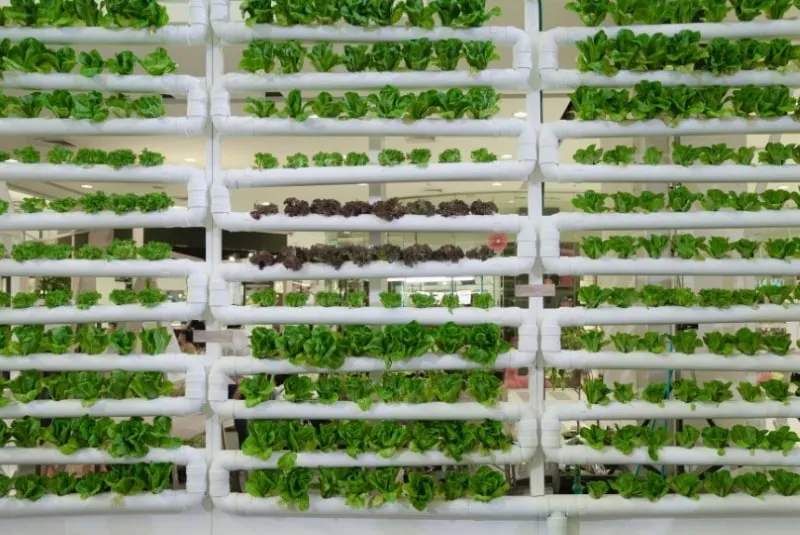
Hydroponic vertical gardening is a game changer for both urban dwellers with limited outdoor or indoor space and traditional gardeners looking for a more efficient method of cultivation. In this blog post, we will delve into what exactly a hydroponic vertical garden is and how it works. We’ll explore the science behind it, the benefits it offers over conventional methods, the types of plants that can thrive in one, and how you can set up your own vertical hydroponics system at home. So, prepare to step into the future of gardening and discover a world where space isn’t a constraint and plants thrive like never before.
- Introduction to Hydroponic Vertical Gardening
- How Does Vertical Hydroponics Work?
- Vertical Vs Horizontal Hydroponics
- What Can You Grow In A Vertical Hydroponic Garden?
- Types of Vertical Hydroponic Garden Growing Structures
- Water and Nutrient Delivery Systems for Vertical Hydroponics
- Lighting Requirements
- Setting Up a Hydroponic Vertical Garden
- Tips for Success with Hydroponic Vertical Gardening
- FAQs
Introduction to Hydroponic Vertical Gardening
Hydroponic vertical gardens are a novel approach to gardening that merges the principles of hydroponics and vertical gardening. The term “hydroponics” refers to the method of growing plants without soil, with the roots submerged in nutrient-enriched water. “Vertical gardening,” on the other hand, refers to the practice of growing plants upward rather than outward, typically on a vertical surface or structure.
When these two concepts are combined, a hydroponic vertical garden is born. This innovative gardening technique allows plants to grow vertically while their roots are nurtured with nutrient-rich water, eliminating the need for soil. The result is a visually attractive, space-saving, and efficient way of growing plants.
Hydroponic vertical gardening systems are not just for professional horticulturists. It’s gaining traction among urban dwellers, food enthusiasts, and eco-conscious individuals. This upsurge in popularity is due to a combination of factors:
- Space Efficiency: With urban spaces becoming increasingly limited, vertical gardens provide an efficient solution for those who wish to grow their own food but lack the necessary ground space.
- Sustainability: Hydroponic vertical gardens use less water than traditional soil-based gardening since the water can be recycled within the system. This feature makes it an attractive option for those who wish to minimize their environmental impact.
- Controlled Environment: Hydroponics allows for greater control over the growing conditions, including nutrient levels and light exposure, making it possible to grow a wider variety of plants year-round, regardless of the weather or season.
- Enhanced Growth Rates: Plants grown hydroponically often grow faster and produce higher yields than those grown in soil, due to the constant access to necessary nutrients.
Despite these significant benefits, it’s important to note that setting up one of these gardens requires an initial investment in equipment and a commitment to regular monitoring and maintenance. However, once established, these systems can yield a substantial amount of produce, providing a continuous supply of fresh food right at your fingertips.
How Does Vertical Hydroponics Work?
Vertical hydroponics is a method of growing plants without soil and using minimal space by stacking the plants vertically. Here’s how it works:
- Grow Medium: Unlike traditional farming, hydroponics doesn’t use soil. Instead, plants are grown in a soilless growing medium that can include materials like peat moss, coconut coir, or perlite. This medium supports the plants’ roots and helps distribute nutrients and water evenly.
- Nutrient Solution: Plants need nutrients to grow. In vertical hydroponics, a nutrient-rich water solution is used, containing all the essential elements a plant needs to thrive. This solution is directly delivered to the plants’ roots.
- Vertical Structure: Plants are arranged in a vertical structure, often in stacked layers. This allows for a high yield of crops in a small footprint, making the system ideal for urban farming or indoor gardening.
- Lighting: If the system is indoors, artificial lights are used to provide the plants with necessary light for photosynthesis. The use of LED lights is common due to their energy efficiency.
- Irrigation: The nutrient solution is delivered to the plants’ roots using a variety of methods. This could be through a drip system, ebb and flow, or deep water culture (DWC). The method used depends on the specific needs of the plants and the design of the hydroponic system.
- Aeration: Roots also need oxygen to absorb nutrients effectively. In some systems, an air pump is used to ensure that the nutrient solution is adequately oxygenated.
Vertical Vs Horizontal Hydroponics
When it comes to hydroponics, the orientation of the garden can make a significant difference. The two main orientations are vertical and horizontal, each with its unique features, advantages, and challenges.
Advantages of Hydroponic Vertical Gardens
- Space Efficiency: One of the primary benefits of vertical hydroponics is its efficient use of space. By growing plants vertically, you can cultivate far more plants in the same square footage compared to traditional horizontal gardening. This feature makes vertical hydroponics an ideal solution for urban farming and indoor gardening where space is a premium.
- Better Light Exposure: In a vertical garden, plants are arranged in a way that they are less likely to overshadow each other, providing each plant with more exposure to light. This leads to more robust and faster growth.
- Reduced Pest and Disease Pressure: With increased air circulation around each plant in a vertical hydroponic system, there is less chance for fungal diseases to take hold. Moreover, pests have a harder time reaching plants that are off the ground.
- Water and Nutrient Efficiency: Vertical hydroponic systems often use recirculating water systems, which means they require less water than traditional horizontal gardens. The direct delivery of water and nutrients to the plant roots also results in less waste.
Disadvantages and Challenges of Hydroponic Vertical Gardens
- Setup Cost and Complexity: Vertical hydroponic systems can be more complex and expensive to set up than their horizontal counterparts. They often require more advanced systems for delivering water and nutrients to each plant, and ensuring each plant receives adequate light can be a challenge.
- Maintenance Requirements: Due to their vertical nature, these gardens can be more challenging to maintain. For instance, reaching plants that are higher up for pruning or harvesting can be difficult.
- Uneven Growth: While vertical systems can provide better light exposure overall, they might also result in uneven growth. Plants at the top of the system may receive more light than those at the bottom, leading to disparities in plant development.
- Risk of System Failure: Vertical systems, especially those that rely on pumps and timers, can be vulnerable to power failures or equipment malfunctions. In such cases, the entire system could be at risk, potentially leading to loss of the entire crop.
While hydroponic vertical gardens have a lot to offer, it’s crucial to consider these challenges and ensure you’re ready to handle them before setting up your system. Discover the differences between horizontal and vertical hydroponic gardens to choose the type for your needs.
What Can You Grow In A Vertical Hydroponic Garden?
When deciding on the best plants for vertical hydroponics, it’s essential to consider which ones will not only thrive but also efficiently use the vertical space. Here is a list of suitable plants that do well in hydroponic vertical garden setups:
- Leafy Greens and Herbs: These types of plants are ideal for hydroponic vertical gardens due to their relatively small root systems and quick growth. Here are some popular choices:
- Lettuce: One of the most common choices for hydroponic gardening, lettuce grows quickly and easily. It doesn’t require a lot of space or much depth for roots, making it perfect for vertical setups.
- Spinach: Like lettuce, spinach is another leafy green that thrives in hydroponic systems. It’s a cool-season crop that can be grown year-round in the controlled environment that hydroponics provides.
- Basil: This herb loves the moist environment of a hydroponic system. Basil plants grow quickly and don’t require a lot of space, making them great for vertical gardens.
- Mint: Known for its vigorous growth, mint can take over a garden. However, in a controlled hydroponic setting, it’s much easier to manage. Mint enjoys the constant water supply that hydroponic systems provide.
- Strawberries and Other Small Fruits: Strawberries are a great choice for hydroponic vertical gardens due to their compact size and love for water. Other small fruits, like blueberries, can also be successfully grown, but they may require more maintenance and care.
- Tomatoes and Peppers: Despite being larger than most plants mentioned so far, tomatoes and peppers can do well in hydroponic vertical systems, especially dwarf or bushy varieties. They have a longer growing season and can produce a bountiful harvest in the right conditions.
- Flowers and Ornamental Plants: Hydroponic vertical gardens are not just for edibles. Many flowers and ornamental plants can thrive in these systems. Marigolds, petunias, and impatiens are just a few examples. These plants add beauty to your vertical garden while also potentially attracting beneficial insects.
Remember, the key to a successful hydroponic vertical garden is choosing plants that match the environment and your gardening goals. Whether you’re growing food or creating a living wall of beauty, there’s a plant that’s perfect for your hydroponic vertical garden.
Types of Vertical Hydroponic Garden Growing Structures
Hydroponic vertical gardens come in various structures. Each design has its unique benefits, catering to different types of gardeners and their specific needs. Understanding these structures will help you select the one that suits your requirements best. Let’s now delve into three popular types of vertical garden structures for hydroponics: vertical towers, wall-mounted systems, and A-frame systems.
Vertical Towers
Vertical towers are one of the most common structures in hydroponic vertical gardening. They are typically cylindrical and can reach several feet in height, allowing for the growth of plants in a very compact space. The towers are designed in a way that water, filled with necessary nutrients, is pumped to the top of the tower and trickles down, reaching each plant on the way.
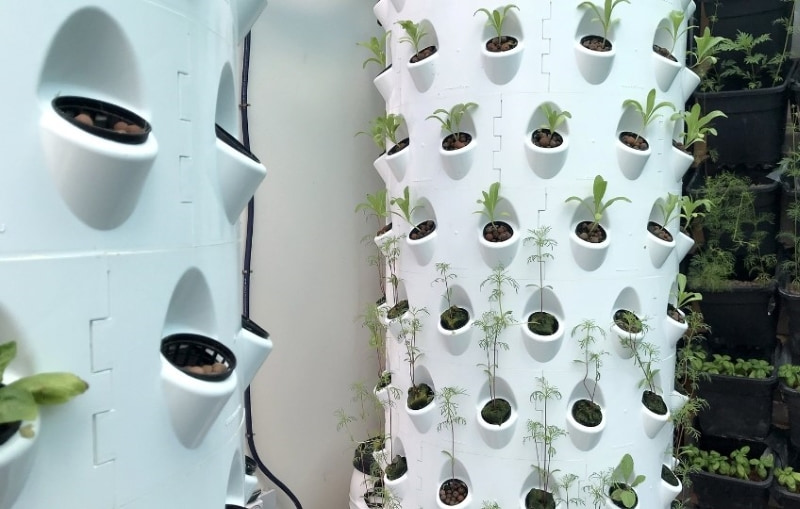
These towers are perfect for crops that prefer a lot of sunlight, as the tower’s design ensures that all the plants receive an equal amount of light. Moreover, they are easy to maintain and harvest due to their accessible height and structure. A hydroponic vertical garden tower is ideal for those with limited ground space, such as urban dwellers or those who wish to grow crops indoors.
Aeroponic towers look quite similar except that nutrient mist is sprayed directly onto the roots.
Wall-Mounted Systems
Wall-mounted systems, as the name suggests, are structures that can be mounted on the wall. This type of hydroponic wall garden brings a decorative aspect to hydroponics, transforming an ordinary wall into a lush, green garden.
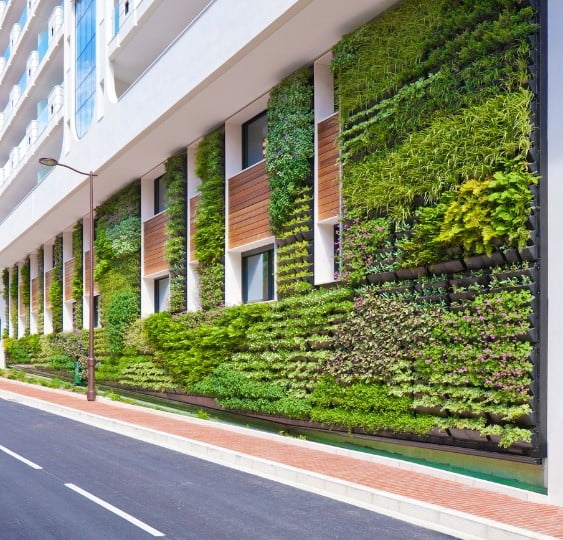
Wall-mounted systems often use a felt-like material to hold the plants in place. The nutrient-rich water is supplied at the top and seeps down, saturating the material and providing the plants with necessary nourishment. This system is an excellent choice for those who want to incorporate greenery into their living or working spaces. It’s also a space-saving solution that can turn any wall into a productive garden.
A-Frame Systems
A-frame systems are another popular choice for hydroponic vertical gardens. This setup consists of a simple A-shaped frame, with plants growing on both sides. The A-frame can be constructed using a variety of materials, including wood or metal, and is often lined with PVC pipes or channels to hold the plants and circulate the nutrient solution.
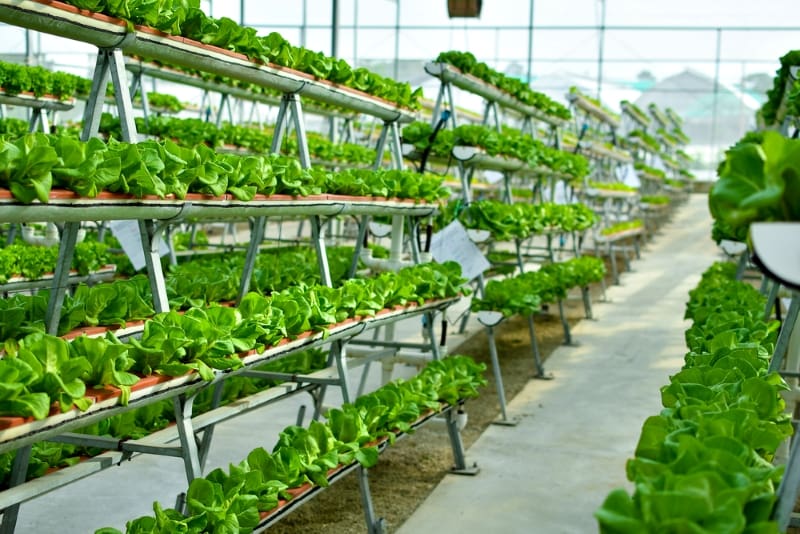
The major advantage of an A-frame system is its efficient use of space. This system allows you to grow a large number of plants in a relatively small area. Additionally, the A-frame’s inclined sides provide sufficient light exposure to all plants. This setup is a great choice for gardeners with a little more space who want to maximize their crop yield.
Water and Nutrient Delivery Systems for Vertical Hydroponics
Drip Irrigation
Drip irrigation is a popular method used in vertical hydroponic gardens. This system works by slowly feeding water and nutrients directly to the roots of each plant. Through a network of tubes and emitters, the nutrient-rich solution is dripped onto the root zone of each plant.
The major advantage of this system is its efficiency; it delivers the right amount of water and nutrients directly to where the plants can utilize them most. Minimizing waste, it helps save water and nutrients compared to traditional soil gardening. Also, drip irrigation systems are quite flexible and can be adjusted to fit the needs of various plants in the vertical garden.
Nutrient Film Technique (NFT)
Nutrient Film Technique, or NFT, is another method used in vertical hydroponic gardens. Unlike the drip irrigation system, NFT does not use any growing medium. Instead, plants are placed in a slightly sloped tray, and a thin film of nutrient-rich water continuously flows over the roots, hence the name “Nutrient Film”.
The film of water is very shallow, allowing the upper parts of the roots to take in ample oxygen from the air, while the lower parts absorb the nutrients from the water. The hydroponic NFT system is particularly successful for plants that don’t need a lot of support and can thrive in a water-based environment. However, it’s crucial to ensure a constant flow of water in NFT systems since any interruption can quickly lead to plant stress or wilting.
Aeroponics
Aeroponics is a method that might seem straight out of a sci-fi movie, but it’s a highly effective way to grow plants in a vertical hydroponic garden. In aeroponic systems, plants are suspended in air, and the roots are misted with a nutrient-rich solution at regular intervals.
By exposing the roots to air, the plants can absorb more oxygen, which can enhance growth and nutrient uptake. Moreover, because the nutrient solution is misted directly onto the roots, the water and nutrient usage is extremely efficient. However, aeroponic systems can be more complex to set up and manage, and they require a reliable misting schedule to ensure the roots do not dry out.
Lighting Requirements
Lighting plays a crucial role in the success of a hydroponic vertical garden. Different plants have unique light requirements, and it’s essential to consider this when setting up your vertical garden.
Natural Light vs. Artificial Grow Lights
When it comes to lighting, you have two primary options: natural light and artificial grow lights.
Natural Light: This is the sun’s light, which is perfect for photosynthesis. It’s the most cost-effective source of light for your plants. However, depending on your location, the amount of sunlight your plants receive may vary. Some places may not get enough sunlight year-round, while others may have too much intense sunlight, which can harm the plants.
Also, remember that a vertical garden can cast shadows, causing lower layers to receive less light. Therefore, if you’re relying on natural light, ensure all plants are positioned to receive enough daylight.
Artificial Grow Lights: These are specially designed lights that provide the right spectrum of light for plant growth. They’re an excellent solution for places with insufficient natural light. Artificial lights can be controlled to give your plants the exact amount of light they need, regardless of the time of year or weather conditions.
There are several types of grow lights available, including LED, fluorescent, and high-intensity discharge (HID) lights. Each type has its own advantages:
- LED (Light Emitting Diode) lights are energy-efficient and long-lasting. They emit less heat, reducing the risk of damaging the plants.
- Fluorescent lights are cost-effective and great for plants that don’t require a lot of light.
- HID (High-Intensity Discharge) lights are powerful and cover a larger area. They’re ideal for larger vertical gardens.
Setting Up a Hydroponic Vertical Garden
Determining the Location and Space Requirements
Setting up a hydroponic vertical garden starts with finding the right spot. The location should provide enough space for the vertical structure and the equipment required for the hydroponic system. The area should also have good air circulation to prevent the growth of mold and other diseases. It’s also important to consider the weight of the fully watered system to ensure the location can support it.
Choosing the Right Vertical Growing Structure for Your Needs
The next step is to select a vertical growing structure that suits your needs. There are many types of structures available, including towers, wall-mounted panels, and freestanding racks. The choice depends on your available space, the type of plants you want to grow, and your budget. A good structure should provide ample support for your plants and allow for efficient water and nutrient delivery. You can even build your own vertical system if you want. Learn here how to build a hydroponic vertical garden wall, tower or A-frame stand.
Selecting the Appropriate Growing Medium
In hydroponic systems, the soil is replaced with a sterile, inert growing medium that holds the roots and provides them with physical support. There are various types of growing mediums available, such as rockwool, coconut coir, clay pebbles, and perlite. The choice of medium depends on the type of hydroponic system and the plants you’re growing.
Installing the Water and Nutrient Delivery System
A crucial component of a hydroponic vertical garden is the water and nutrient delivery system. This system ensures that your plants receive the right amount of water and essential nutrients directly to their roots. The system typically includes a reservoir, a submersible pump, tubing, and emitters. The pump pushes the nutrient solution from the reservoir through the tubing and delivers it to the plants via the emitters.
Setting Up the Lighting System
Proper lighting is essential for plant growth. If you’re choosing to build an indoor hydroponic vertical garden or in a place with limited natural light, you’ll need to set up a lighting system. The most common lights used for hydroponics are LED grow lights, fluorescent lights, and high-intensity discharge (HID) lights. The choice of lighting depends on the plants you’re growing, the size of your garden, and your budget.
Seeding or Transplanting Your Chosen Plants
Finally, it’s time to introduce plants to your system. You can start your hydroponic vertical garden with seeds or transplant seedlings. If you’re using seeds, place them in the growing medium and ensure they’re adequately moist. For transplanting, carefully place the seedlings into the growing medium without damaging the roots. Remember to clean the seedlings’ roots if you’re transferring them from soil to prevent the introduction of pests or diseases into your hydroponic system.
Tips for Success with Hydroponic Vertical Gardening
Embarking on the journey of hydroponic vertical gardening can be exciting and rewarding. Here are some tips to ensure your adventure is a successful one:
- Start with Easy-to-Grow Plants: As a beginner, it’s a good idea to start with plants that are known for their hardiness and ease of growth in hydroponic systems. Lettuce, spinach, and herbs such as basil and parsley are excellent choices. Once you’ve gained more experience and confidence, you can start experimenting with different plants.
- Follow Recommended Spacing Guidelines: While vertical gardening allows for a high density of plants, overcrowding can lead to poor growth and disease spread. Make sure to follow the recommended spacing guidelines for each plant type you’re growing. This will ensure that your plants have sufficient room to grow and access to necessary light and air circulation.
- Regularly Monitor and Adjust Environmental Conditions: The success of your hydroponic vertical garden largely depends on optimal environmental conditions. Regularly check and adjust the temperature, humidity, light levels, and pH of your system. These parameters can significantly impact plant health and yield.
- Be Consistent with Watering and Nutrient Delivery: Consistency is key in hydroponic gardening. Make sure your plants are receiving a steady supply of water and nutrients. Automated systems can help with this, but if you’re watering manually, create a schedule and stick to it. Also, remember to routinely check the water and nutrient levels in your system.
- Learn from Your Experiences and Experiment with Different Plant Varieties: Every hydroponic gardener’s experience is unique, and there’s always something new to learn. Keep a gardening journal to record your observations and track your plants’ progress. This will help you understand what works best for your specific setup. Don’t be afraid to experiment with different plant varieties or growing techniques. This can lead to new discoveries and make your hydroponic gardening journey even more fulfilling.
Remember, every successful gardener started as a beginner. With patience, dedication, and a willingness to learn, you’ll soon be enjoying the fruits (and vegetables) of your hydroponic vertical garden.



